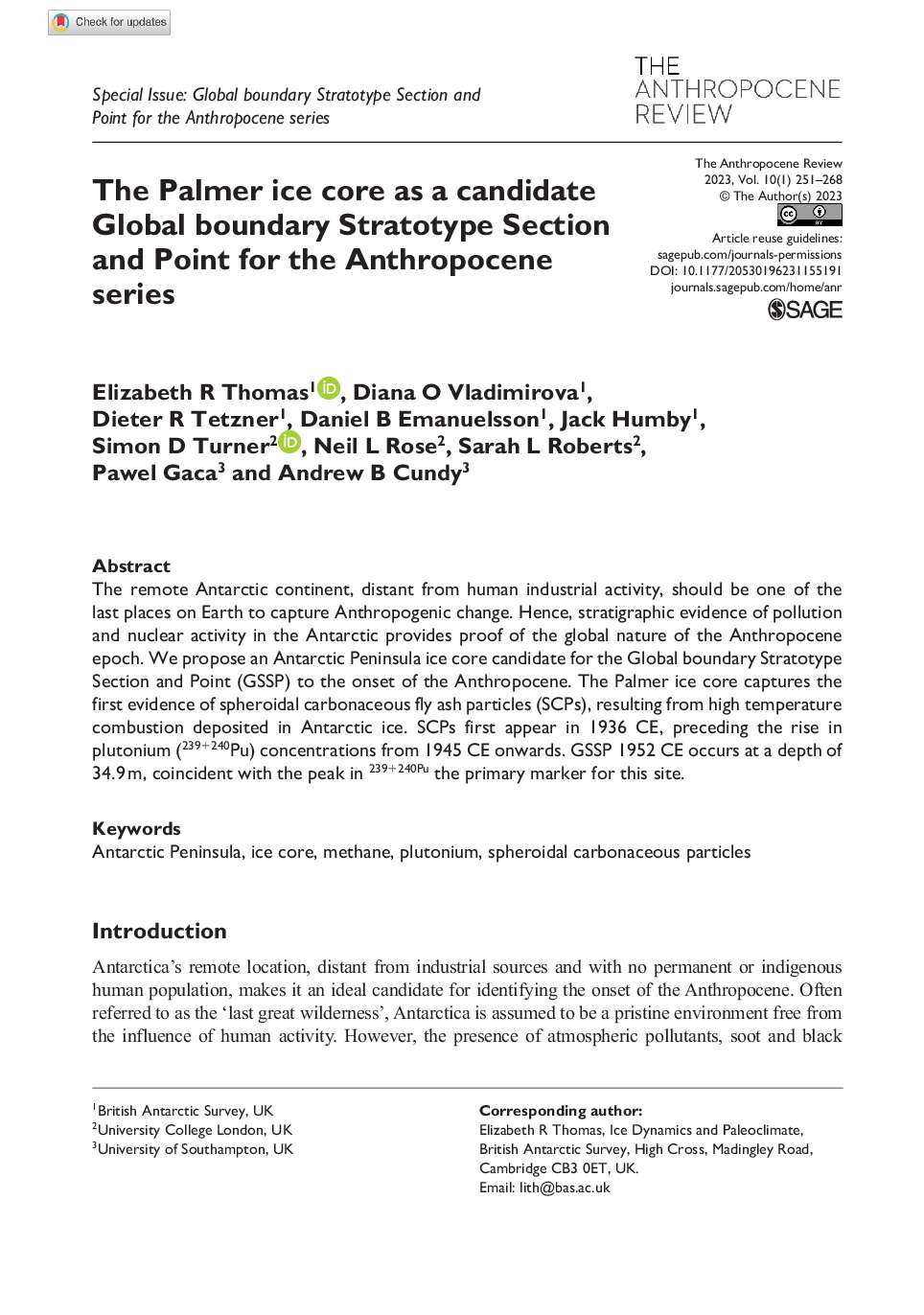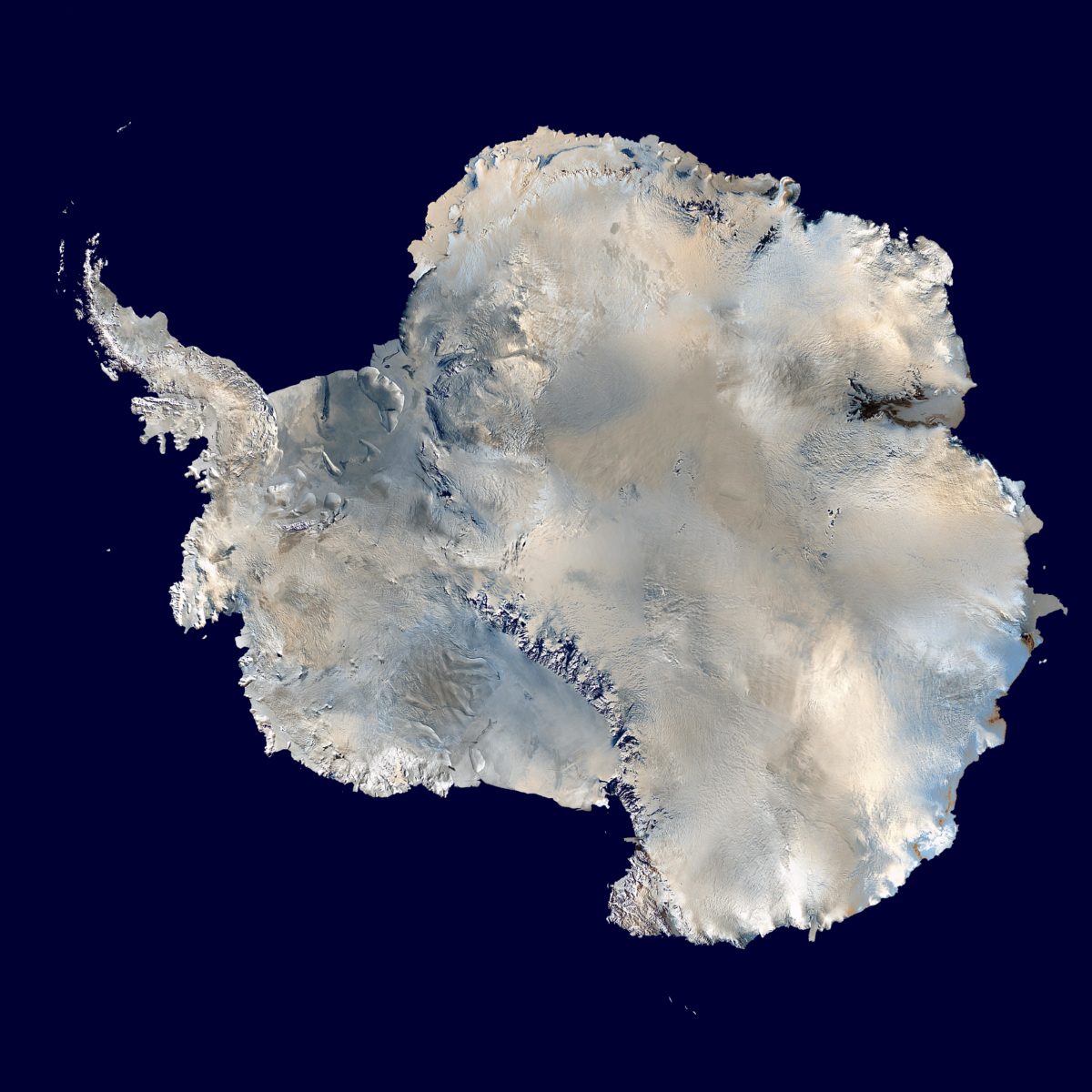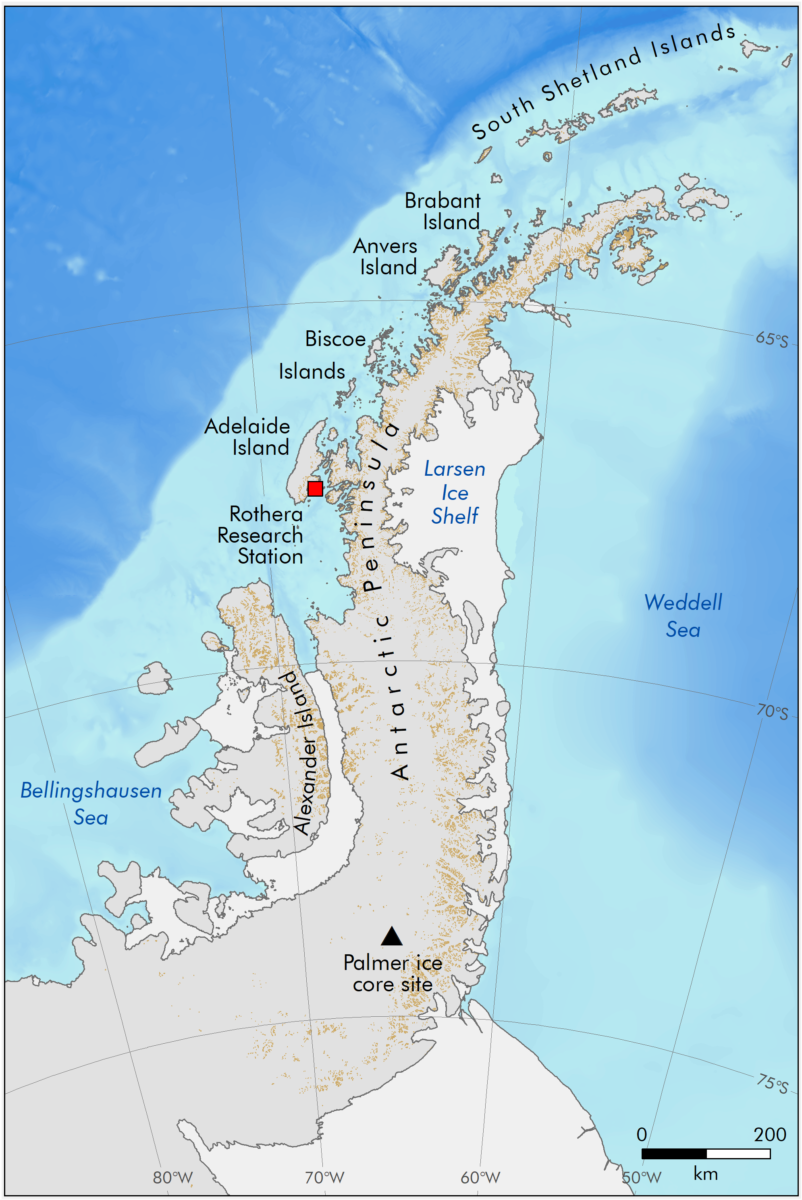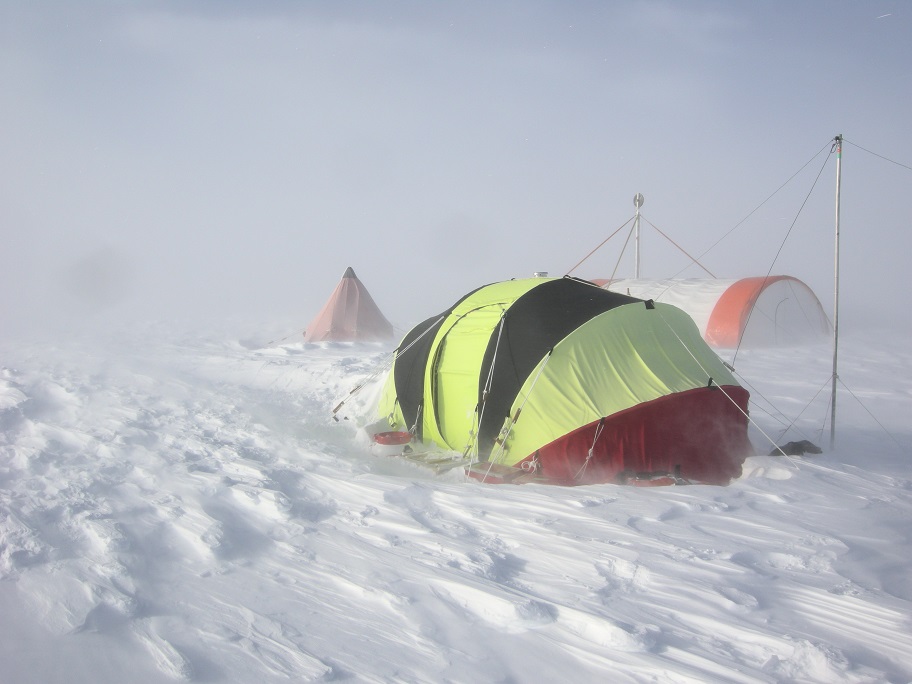Antarctic Peninsula, Antarctica

Site Introduction
The Antarctic Peninsula—the northernmost arm of the planet’s coldest, most remote continent—extends into the Southern Ocean toward the tip of South America. The peninsula is 522,000 square kilometers, and alongside mountains, glaciers, and extremely high winds, it is home to penguins, seals, humpback whales, and scientists living at research stations established by eighteen different nations. The peninsula is the warmest and wettest region of Antarctica, with above-zero temperatures during the summer and snowfall exceeding four meters per year in some areas. The Palmer ice core was extracted from the Antarctic Peninsula ice sheet, an approximately 500-meter-thick ice sheet that sits within a 1300-kilometer-long, Alpine-style mountain chain, the highest point of which is Mount Hope, at 3,239 meters above sea level.
Humans did not discover Antarctica until the early nineteenth century, and did not explore it until the early twentieth, making it the last continent on Earth to be mapped and studied. However, its remoteness and lack of permanent habitation does not mean its delicate ecosystems have been immune to human influence. Heavy fishing in the waters surrounding the peninsula, research station infrastructure and pollution, oil spills, tourism, and invasive species (unintentionally brought by humans) have all impacted the native wildlife, while the climate crisis is disrupting the weather patterns, ocean currents, and ice sheets upon which the polar ecosystem depends. The Antarctic Peninsula is one of the fastest-warming places on Earth, having already experienced an increase in average annual temperature of 2–3 °C. In recent decades, several of the peninsula’s ice shelves have collapsed, ice flow1 velocities have increased, and glaciers are thinning. At present, the peninsula ice sheet is losing ice mass at a rate of around 330 gigatons per year, and if it were to melt entirely, global mean sea levels would rise by twenty-four centimeters.
Antarctica. An orthographic projection of NASA's Blue Marble data set (1 km resolution global satellite composite). Image by Dave Pape, Wikimedia Commons, public domain
Location of the Core
Ice sheets form when snow accumulates and becomes compacted, turning into dense glacial ice. The layers of ice—and the air bubbles trapped within them—preserve particles of dust, ash, pollen, and trace elements, as well as atmospheric gases such as carbon dioxide and methane from the time the snow was deposited. Ice cores thus form valuable archives that can extend back hundreds of thousands of years and that allow scientists to reconstruct past atmospheric, climatic, and environmental conditions. Indeed, the air trapped in ice cores is the only direct record we have of atmospheric compositions that predate modern measurements. The temperature at the core site (1,897 meters above sea level) ranges from −30 °C during the winter to −15 °C in the summer—cold enough that the area remains free from surface melt, which might otherwise damage the paleoclimate record.
Antarctic ice cores store information about local conditions, including past surface temperature, snowfall amount, ocean and atmospheric circulation, sea ice extent, and marine productivity, as well as global or distant conditions such as pollution and volcanic eruptions. Huge peaks in sulfur correlate with known volcanic eruptions, enabling accurate dating of the core. Meanwhile the polar seasons—twenty-four-hour sunlight in high summer and twenty-four-hour darkness in deep winter—are legible in the cores through levels of hydrogen peroxide (which is degraded by sunlight), sulfur compounds and biological traces (which vary according to seasonal marine productivity), and stable water isotopes2 (which vary according to surface temperature). These volcanic and seasonal signals thus allow scientists to produce a very high resolution and accurate age-scale (with an error bar of just three months) by counting the annual layers.
While atmospheric aerosols3 and pollutants reach mainland Antarctica only in very small concentrations, the meteorology of the peninsula means that the ice there captures anthropogenic changes in climate, land use, and heavy industry in the southern hemisphere landmasses and beyond. The peninsula acts as a barrier to the westerly wind belt—a region of near constant strong winds that encircles Antarctica and carries atmospheric aerosols and pollutants from distant landmasses—while a prominent low-pressure system ensures constant snow deposits that create a continuous record in the ice sheet.
The Antarctic Peninsula, with the Palmer ice core site and Rothera Research Station (the largest British Antarctic Survey facility) marked. Image by Laura Gerrish at the British Antarctic Survey © All Rights Reserved
Field camp at the Palmer core collection site on the Antarctic Peninsula ice sheet. Photograph by Liz Thomas © All Rights Reserved Field camp at the Palmer core collection site on the Antarctic Peninsula ice sheet. Photograph by Liz Thomas © All Rights Reserved
The Core and Results
The 133-meter-long Palmer ice core holds records from 1621–2012, which means that there are almost 400 years of pre-Anthropocene data with which to compare the mid-twentieth-century changes. It is currently the longest ice core record from the Antarctic Peninsula.
A clear ongoing rise in average surface temperature (recorded by stable water isotopes4) is visible from the 1950s, with increases in the 1990s corresponding to the breakup of the Larsen Ice Shelf. This shelf extends along the east coast of the Antarctic Peninsula and has reduced in size from 85,000 square kilometers to 67,000 square kilometers in the last thirty years. While comparable high surface temperatures are visible throughout the core (i.e., going back to the seventeenth century), it is only after 1950 that the warmer temperatures are consistent enough to lead to the disintegration of the ice shelf. Similarly, the core also records a big rise in both extreme precipitation events and annual snowfall (calculated by measuring the varying thickness of annual layers) from the mid-twentieth century onward, with the latter increasing to almost four times the preindustrial average. The increase in snowfall is driven by changes in atmospheric circulation caused by global warming.
Levels of methane—a greenhouse gas with eighty times the warming effect of carbon dioxide—increases from 700 parts per billion in the preindustrial era to 1800 parts per billion in the 1990s, caused by human agriculture and industry. A notable acceleration in the methane record was detected in 1958 (+/- 5-years). Spheroidal carbonaceous particles (SCPs)5 have also been identified in the Palmer ice core, with the earliest particle deposited in 1936. Although SCPs appear in the core only in small numbers, this is the first ice core evidence that fly ash has reached the Antarctic continent.
The first evidence of plutonium-239 and plutonium-240 in the Palmer ice core occurs in the ice layer corresponding to the years 1945–6. This is coincident with the earliest bomb tests in July 1945. The concentrations of plutonium-239 and plutonium-240 increased after 1945, reaching a maximum in the ice layer corresponding to 1960–1.
Collection and Analysis
A 133-meter-long core was collected from the Palmer Land ice sheet in December 2012 using the British Antarctic Survey (BAS) electromechanical ice core drill. No drilling fluid was used to minimize the risk of contaminating the core. The core was cut into 80-centimeter-long sections on site and then transported to the BAS ice core laboratories at the University of Cambridge, UK, for analysis. Various chemical, isotopic, and gas measurements were made using a bespoke continuous flow analysis method. This method involves melting the core from one end with a hot plate, discarding the outer material (which might be contaminated through contact during sampling or transportation), and then directing the inner material through various instruments for analysis. The core was subjected to the following analyses: stable water isotopes (oxygen and deuterium), conductivity, dust, major ions and chemical species (including sulfate, nitrate, ammonium, chloride, methane sulphonic acid, sodium, calcium, magnesium, and potassium), and methane.
The Research Team
Liz Thomas is head of the ice core research group at the British Antarctic Survey, an active research team comprising senior researchers, postdoctoral researchers, analytical chemists, technicians, ice core drilling engineers, and PhD students. Thomas has led several expeditions to Antarctica and the Arctic (Greenland and Svalbard), and recently led an expedition to drill the first ever ice cores from the sub-Antarctic islands. Her research has improved our understanding of Antarctic surface mass balance, highlighted the significance of the Antarctic Peninsula, and quantified the twentieth-century contribution to global sea levels (see, e.g., Thomas et al., 2017; Medley and Thomas, 2019).
The GSSP research team includes BAS postdoctoral researchers Daniel Emanuelsson, Diana Vladimirova, Jack Humby, and Dieter Tetzner. Together the team analyzed the 133-meter-long Palmer ice core for stable water isotopes, and chemical and gas measurements using a bespoke continuous flow analysis method (Grieman et al., 2021). Thomas and her team have produced an accurate age-scale for the Palmer ice core (Emanuelsson et al., 2022). Thus, the team was able to sub-sample the Palmer ice core at annual resolution for additional analysis by the GSSP collaborators.
Neil Rose, Simon Turner, and Sarah Roberts are experts in the detection of SCPs, and have sampled fly ash in a range of archives from across the globe. The analysis of the Palmer samples was their first attempt to detect fly ash particles in an ice core from Antarctica.
The team is joined by Andy Cundy, an expert in environmental radioactivity, including the analysis of plutonium isotopes as traces of contaminant sources and environmental processes. He has been adapting an existing method to measure plutonium in the samples from the Palmer ice core.
The Palmer core research team. From left to right: Dr Dieter Tetzner, Dr Daniel Emanuelsson, Dr Jack Humby, Dr Liz Thomas, and Dr Diana Vladimirova. Photograph by Liz Thomas © All Rights Reserved
Principal investigator:
Elizabeth Thomas, British Antarctic Survey
Contributing Scientists/Researchers (listed alphabetically):
Andy Cundy, University of Southampton, Plutonium analysis
Daniel Emanuelsson, British Antarctic Survey, Ice core analysis
Jack Humby, British Antarctic Survey, Ice core analysis
Shaun Miller, British Antarctic Survey, Ice core technician
Julius Rix, British Antarctic Survey, Ice core drilling engineer
Sarah Roberts, University College London, SCP analysis
Neil Rose, University College London, SCP analysis
Diana Vladimirova, British Antarctic Survey, Ice core analysis


This article is distributed under the terms of the Creative Commons Attribution-NonCommercial 4.0 License (https://creativecommons.org/licenses/by-nc/4.0/) which permits non-commercial use, reproduction and distribution of the work without further permission provided the original work is attributed as specified on the SAGE and Open Access page (https://us.sagepub.com/en-us/nam/open-access-at-sage).
- British Antarctic Survey Ice Dynamics and Palaeoclimate team website
Emanuelsson, Daniel B, Elizabeth R Thomas, Dieter R Tetzner, Jack D Humby, and Diana O Vladimirova. 2022. “Ice Core Chronologies from the Antarctic Peninsula: The Palmer, Jurassic, and Rendezvous Age-Scales.” Geosciences 12 (2): 87. https://doi.org/10.3390/geosciences12020087.
Grieman, Mackenzie M, Helene M Hoffmann, Jack D Humby, Robert Mulvaney, Christoph Nehrbass-Ahles, Julius Rix, Elizabeth R Thomas, Rebecca Tuckwell, and Eric W Wolff. 2022. “Continuous Flow Analysis Methods for Sodium, Magnesium and Calcium Detection in the Skytrain Ice Core.” Journal of Glaciology 68 (267): 90–100. https://doi.org/10.1017/jog.2021.75.
Medley, B., and E. R. Thomas. 2018. “Increased Snowfall over the Antarctic Ice Sheet Mitigated Twentieth-Century Sea-Level Rise.” Nature Climate Change 9 (1): 34–39. https://doi.org/10.1038/s41558-018-0356-x.
Rose, Neil L. 2015. “Spheroidal Carbonaceous Fly Ash Particles Provide a Globally Synchronous Stratigraphic Marker for the Anthropocene.” Environmental Science & Technology 49 (7): 4155–62. https://doi.org/10.1021/acs.est.5b00543.
Thomas, E. R, J. S Hosking, R. R Tuckwell, R. A Warren, and E. C Ludlow. 2015. “Twentieth Century Increase in Snowfall in Coastal West Antarctica.” Geophysical Research Letters 42 (21): 9387–93. https://doi.org/10.1002/2015GL065750.
Thomas, E. R, P. F Dennis, T. J Bracegirdle, and C Franzke. 2009. “Ice Core Evidence for Significant 100-Year Regional Warming on the Antarctic Peninsula.” Geophysical Research Letters 36 (20): L20704–n/a. https://doi.org/10.1029/2009GL040104.
Thomas, Elizabeth R, and Thomas J Bracegirdle. 2014. “Precipitation Pathways for Five New Ice Core Sites in Ellsworth Land, West Antarctica.” Climate Dynamics 44 (7–8): 2067–78. https://doi.org/10.1007/s00382-014-2213-6.
Thomas, Elizabeth R, Gareth J Marshall, and Joseph R McConnell. 2008. “A Doubling in Snow Accumulation in the Western Antarctic Peninsula Since 1850.” Geophysical Research Letters 35 (1): L01706–n/a. https://doi.org/10.1029/2007GL032529.
Thomas, Elizabeth R, J. Melchior|info:eu-repo/dai/nl/413533085 van Wessem, Jason Roberts, Elisabeth Isaksson, Elisabeth Schlosser, Tyler J Fudge, Paul Vallelonga, et al. 2017. “Regional Antarctic Snow Accumulation over the Past 1000 Years.” Climate of the Past 13 (11): 1491–1513. https://doi.org/10.5194/cp-13-1491-2017.
Thomas, Elizabeth R, Thomas J Bracegirdle, John Turner, and Eric W Wolff. 2013. “A 308 Year Record of Climate Variability in West Antarctica.” Geophysical Research Letters 40 (20): 5492–96. https://doi.org/10.1002/2013GL057782.
Thomas, E.R., Tetzner, D.R., Roberts, S.L. et al. First evidence of industrial fly-ash in an Antarctic ice core. Sci Rep 13, 6529 (2023). https://doi.org/10.1038/s41598-023-33849-x.




















